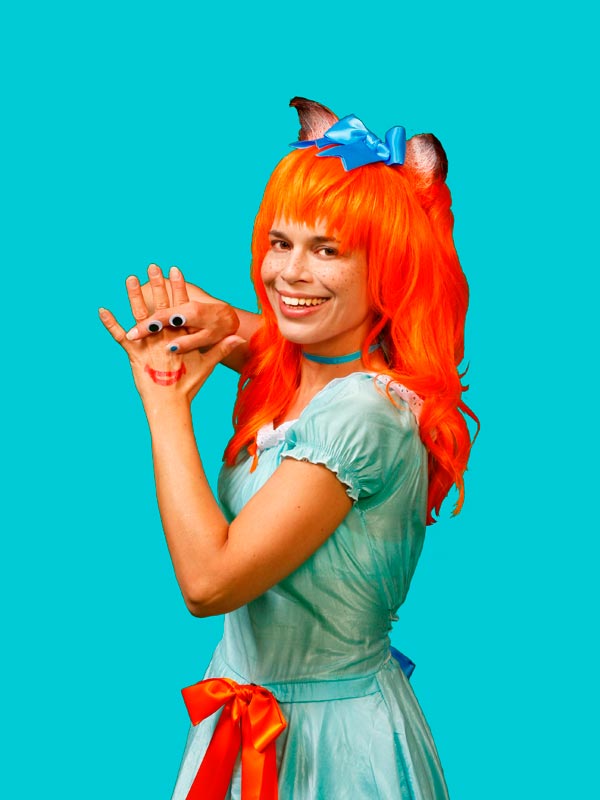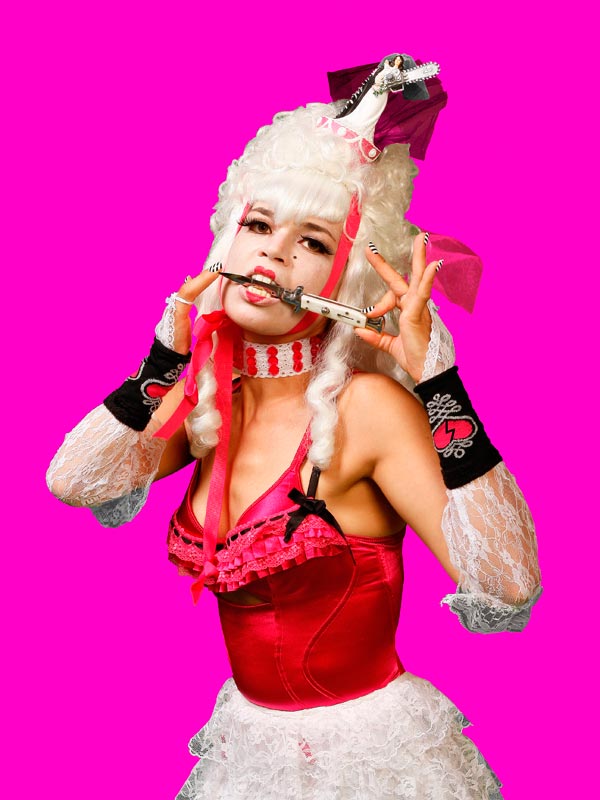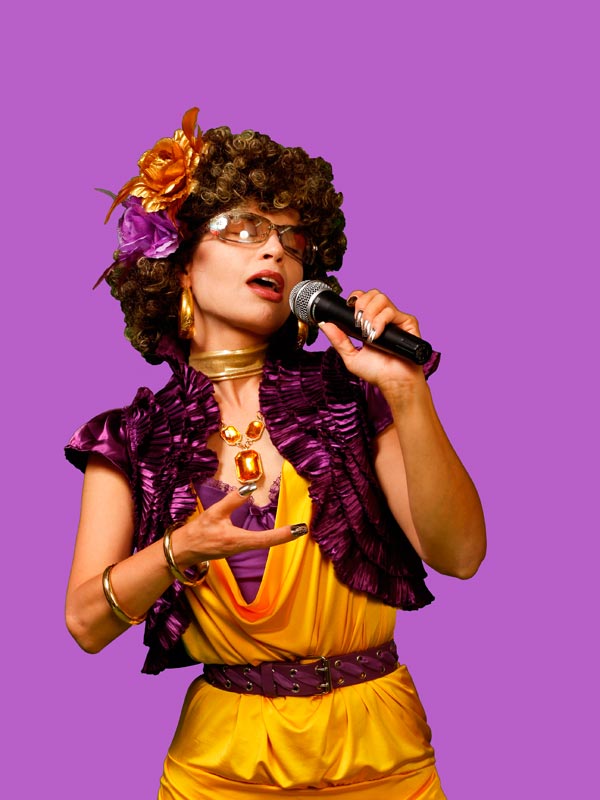



*** The 3 Legged Fox TM ***
*** Ben Wa Betty TM ***
*** The Marquis Sha De TM ***
*** Techno Holiday TM ***
The 3 Legged Fox is a personification of Liz Gibson’s childhood. As a child born with a birth defect, the character’s performances and stories explore themes of becoming aware of being different. This awareness is discovered through social reaction to Gibson’s physical deformity proceeded by her subsequent change in self-perception.
The archetype for the artist’s character is that of the wounded animal. Gibson weaves metaphor’s about primal being with a real life tale from her childhood of a fox that chewed it’s own paw off to escape a foot trap. Themes of: the naturalness of difference, peer reaction to deformity, adaptation, childhood belief in magic, and empathy are explored with this character.
Blue and Orange are the colors used to represent Gibson’s 3 Legged Fox. The character’s costumes, handprints, videos, and other artistic efforts employ this same color scheme. Blue is used to represent “the blues” in reference to the sadness experienced via the loss of innocence. This theme is exemplified in Gibson’s stories from childhood involving the transformation she undergoes once she is made aware of her own physical difference mirrored by the story of struggle and transformation experienced by a real life three legged fox.
Orange is used in the artist’s work as a complimentary color to blue. It is used in reference to the color of fox fur, and is worn in Gibson’s many 3 Legged Fox costumes as the color of her fox ears and tail.
Liz Gibson’s adolescence is represented by her Ben Wa Betty character. Adaptation is a major theme of the character. The adaptation takes place first as a teenage struggle to conform to social norms, and then upon failing to conform, a rejection of social norms followed by an adaptation through self-acceptance.
Orientalism referring to the study of the “Asian Other” influenced the Asian themes of the Ben Wa Betty character. In regards to Gibson’s work, the context is the deformed as the “Social Other”. The archetypal “Dragon Lady”- who is simultaneously beautiful, mysterious, freakish, and dangerous, is another influence on Gibson’s persona. Rejection and Acceptance in terms of social perception and self-perspective are the major themes of this character.
Green is used to represent the color of dragons and jade, thus reinforcing the character’s Asian theme. It’s compliment, red, is representational of warning and danger. A warning light, a stop sign, or the morbid curiosity that compels one to look behind the red curtain of a freak show, are all imbued in Ben Wa Betty’s red. Blood is also being represented in the abstract in regards to female adolescence and the beginning of mensuration, thus sexuality. Combinations of green and red appear in all of Gibson’s artworks that pertain to the Ben Wa Betty character.
The performance artist’s life in contemporary society is symbolized by Liz Gibson’s Marquis Sha De character. As an adult, Gibson has surpassed the adversity of being deformed, thus becoming empowered. Now her character’s theme revolves around issues of the ego. The Marquis Sha De is a character that struggles to balance the self-confidence that is necessary to be an artist with the egotism she has acquired from her own self-empowerment. The character barely acknowledges her deformity, only using it as a decorative motif.
The Marquis Sha De character has the persona of a diva. Her aesthetic is the combination of a nineteenth century burlesque dancer and Marie Antoinette. Gibson engages in an archetypal French prima donna attitude when performing as this character. Themes of: the hysterical bride, rejection of domesticity, exaggerated ego, and conflicted femininity are explored with this character.
Similar to Liz Gibson’s other performance characters, The Marquis Sha De character abides by a strict color code. The color pink is used in works pertaining to this character to symbolize all that is feminine. The pink is juxtaposed by the color black- to represent a rejection of archetypal feminine roles. Black symbolizes death to expected feminine roles such as that of the bride, the housewife, and the mother.
The Techno Holiday character represents the conclusion to Liz Gibson’s life as an artist. It is both an amalgam of her past characters, as well as, the climax to her life’s story told via performance art. Gibson’s positive speculations are based on being successful as an artist and living a fulfilled life. Her themes follow ideas of: self-contemplation, the life well lived, giving back to society, happily ever after and heaven. At this stage of the character’s development, she has learned to completely embrace her disability and to share her experience with others.
The archetype for the Techno Holiday character is the human at it’s fullest potential. At the conclusion of a long career, she now uses her art to inspire others. She acts gracious, humble, and angelic in her performances. With a disposition of the upmost sincerity, the Techno Holiday character takes on the persona of a revered rock star who is genuinely humbled by the appreciation of her fans.
Purple and yellow are the colors used to symbolize Gibson’s Techno Holiday character. Purple stands for regalness, stateliness, and royalty. Yellow refers to gold. In this context gold means the highest standard, something of the greatest value, an indication of the highest level one can achieve. Both colors combined ultimately to represent the richness that can be achieved by living a soulful existence.